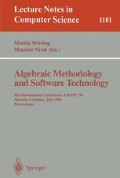Abstract
The Opal system has been used in teaching and research activities. The experience that we have gained from working on and with the Opal system indicates that, functional programming is indeed well suited for producing “real-life” software. This result coincides with the findings of other research teams working in this area. The integration of algebraic specification constructs into a functional language as it is done in the Opal system helps in closing the gap between the two worlds of formal specification and efficient implementation. We feel confident that the functional paradigm, supported by formal methods, will eventually provide a basis for industrial software development.
Preview
Unable to display preview. Download preview PDF.
References
F.L. Bauer, M. Broy, B. Möller, P. Pepper, M. Wirsing, et al. The Munich Project CIP. Vol. I: The Wide Spectrum Language CIP-L, volume I of Lecture Notes on Computer Science. Springer Verlag, Berlin, Heidelberg, New York, Berlin, 1985.
M. Broy and S. Jälmichen. KORSO, Correct Software by Formal Methods. Springer, 1994.
Klaus Didrich, Andreas Fett, Carola Gerke, Wolfgang Grieskamp, and Peter Pepper. OPAL: Design and Implementation of an Algebraic Programming Language. In Jürg Gutknecht, editor, Programming Languages and System Architectures, International Conference, Zurich, Switzerland, March 1994, LNCS 782, pages 228–244. Springer, 1994.
P. H. Hartel et al. Benchmarking implementations of functional languages with “pseudoknot”, a Float-Intensive benchmark. J. functional programming, to appear, 1996.
Thomas Frauenstein, Wolfgang Grieskamp, Peter Pepper, and Mario Südholt. Concurrent functional programming of graphical user interfaces. Technical Report 95-19, TU Berlin, 1996. to appear.
Joseph A. Goguen and Timothy Winkler. Introducing OBJ3. Technical Report SRI-CSL-88-9, SRI International, 1988.
Wolfram Schulte and Wolfgang Grieskamp. Generating Efficient Portable Code for a Strict Applicative Language. In Phoenix Seminar and Workshop on Declarative Programming. Springer-Verlag, 1992.
Douglas R. Smith. KIDS: A semiautomatic program development system. IEEE Transactions on Software, Engineering, 16(9):1024–1043, September 1990.
Author information
Authors and Affiliations
Editor information
Rights and permissions
Copyright information
© 1996 Springer-Verlag Berlin Heidelberg
About this paper
Cite this paper
Didrich, K., Gerke, C., Grieskamp, W., Maeder, C., Pepper, P. (1996). Towards integrating algebraic specification and functional programming: the Opal system. In: Wirsing, M., Nivat, M. (eds) Algebraic Methodology and Software Technology. AMAST 1996. Lecture Notes in Computer Science, vol 1101. Springer, Berlin, Heidelberg. https://doi.org/10.1007/BFb0014341
Download citation
DOI: https://doi.org/10.1007/BFb0014341
Published:
Publisher Name: Springer, Berlin, Heidelberg
Print ISBN: 978-3-540-61463-0
Online ISBN: 978-3-540-68595-1
eBook Packages: Springer Book Archive

